2022 TOYOTA COROLLA brake light
[x] Cancel search: brake lightPage 243 of 678
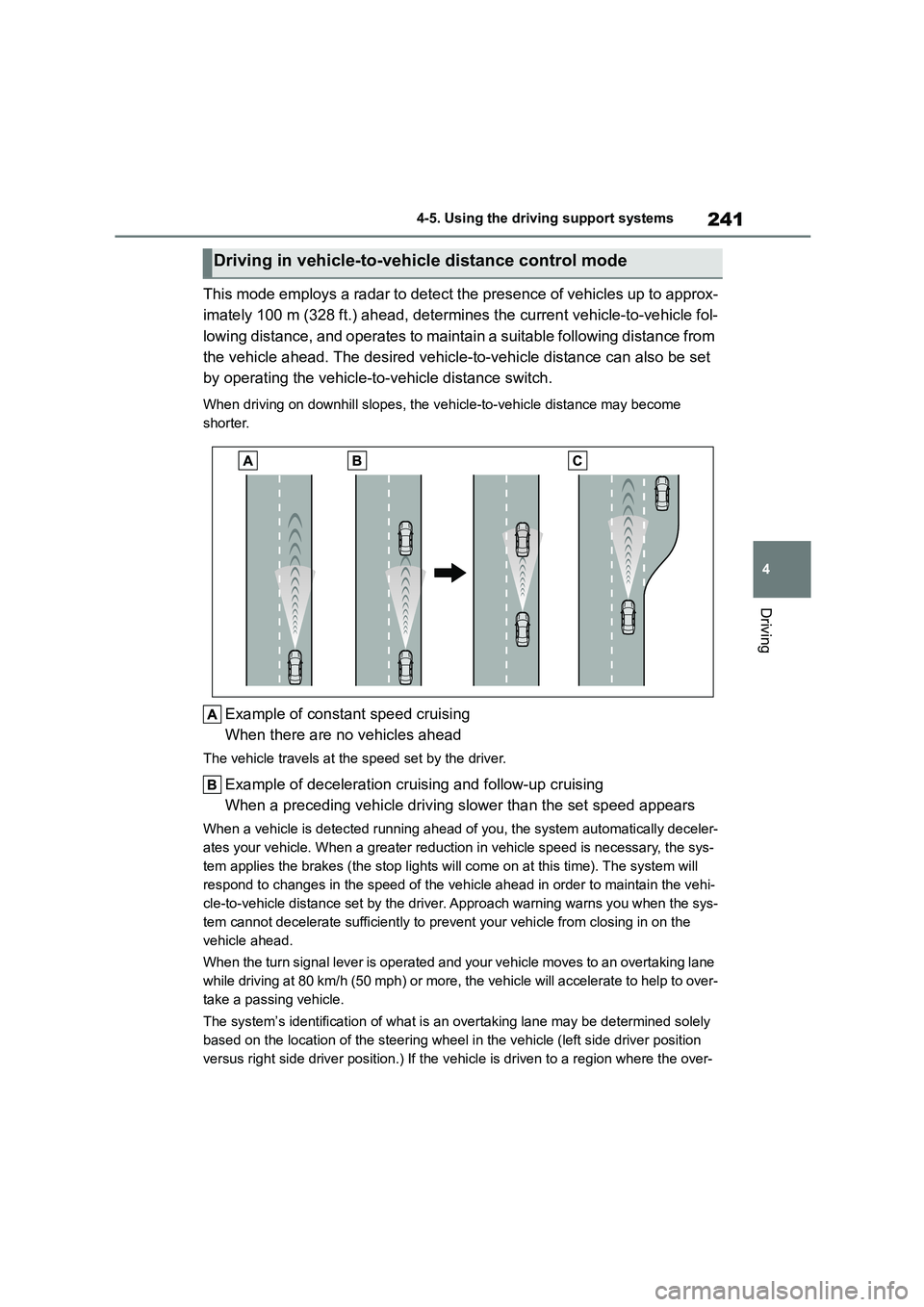
241
4
4-5. Using the driving support systems
Driving
This mode employs a radar to detect the presence of vehicles up to approx-
imately 100 m (328 ft.) ahead, determines the current vehicle-to-vehicle fol-
lowing distance, and operates to maintain a suitable following distance from
the vehicle ahead. The desired vehicle-to-vehicle distance can also be set
by operating the vehicle-to -vehicle distance switch.
When driving on downhill slopes, the vehicle-to-vehicle distance may become
shorter.
Example of const ant speed cruising
When there are no vehicles ahead
The vehicle travels at the speed set by the driver.
Example of deceleration cruising and follow-up cruising
When a preceding vehicle driving slower than the set speed appears
When a vehicle is de tected running ahead of you, the system automatically deceler-
ates your vehicle. When a greater reduction in vehicle speed is necessary, the sys-
tem applies the brakes (the stop lights will come on at this time). The system will
respond to changes in the speed of the vehicle ahead in order to maintain the vehi-
cle-to-vehicle distance set by the driver. Approach warning warns you when the sys-
tem cannot decelerate sufficiently to prevent your vehicle from closing in on the
vehicle ahead.
When the turn signal lever is operated and your vehicle moves to an overtaking lane
while driving at 80 km/h (50 mph) or more, the vehicle will accelerate to help to over-
take a passing vehicle.
The system’s identificat ion of what is an overtaking lane may be determined solely
based on the location of the steering wheel in the vehicle (left side driver position
versus right side driver position.) If the v ehicle is driven to a region where the over-
Driving in vehicle-to-vehicle distance control mode
Page 296 of 678

2944-5. Using the driving support systems
3When a level beep is emitted
and the stop display ( P.290) is
shown on the display, stop the
vehicle.
4 When the shift lever is changed
to R, a high-pitched beep is
emitted and assi st control will
start.
When the steering wheel auto
operation starts, the steering
wheel auto operation display and
assistance level indicator
( P.290) will be shown in the
display area.
To stop assist control, press the
S-IPA switch.
5 Assume an ordinary posture for
backing up, rest your hands
lightly on the steering wheel
without applying any force,
directly confirm the safety of the
area to the rear and around the
vehicle, confirm that there are
no obstacles in the parking
space, and slowly back up while
adjusting your speed by
depressing the brake pedal.
When backing up too quickly, a
sharp beeping sound is emitted
and assist control is stopped.
( P.291)
When the vehicle cannot be
cleanly entered within the target
parking spot on the first try and
multi-turn maneuvering is neces-
sary, proceed to step 6.
When multi-turn maneuvering is
not necessary, proceed to step
12 .
6 When a level beep is emitted
and the stop display ( P.290) is
shown on the display, stop the
vehicle.
7 Change the shift lever to D or M.
8 Assume an ordinary driving pos-
ture, rest your hands lightly on
the steering wheel without
applying any force, directly con-
firm the safety of the area to the
front and around the vehicle and
Page 297 of 678

295
4
4-5. Using the driving support systems
Driving
slowly proceed forward while
adjusting your speed by
depressing the brake pedal.
9 When a level beep is emitted
and the stop display ( P.290) is
shown on the display, stop the
vehicle.
10 Change the shift lever to R.
11 Assume an ordinary posture for
backing up, rest your hands
lightly on the steering wheel
without applying any force,
directly confirm the safety of the
area to the rear and around the
vehicle slowly back up while
adjusting your speed by
depressing the brake pedal.
Depending on the condition of the park-
ing space, steps 6 to 11 may need to be repeated.
12 When the vehicle is almost
entirely within the target parking
spot, a high-pitched beep is
emitted and the stop display is
shown on the display, stop the
vehicle.
This completes th e parallel parking assist mode.
After stopping, feel free to
maneuver the vehicle to reach
the desired parking spot.
Be sure to back up while check-
ing the area to the front and rear
of the vehicle directly and by
using the mirrors.
■Parallel parking assist mode oper-
ating conditions
●In order to operate the parallel parking
assist mode correctly, drive slowly (at
a speed at which the vehicle can be quickly stopped) parallel to the road
(or shoulder) while maintaining a dis-
tance of approximately 1 m (3.3 ft.) to any parked vehicles.
●The function cannot be used when the vehicle speed is approximately 30
km/h (19 mph) or higher.
●The front side sensors and rear side
sensors are used to detect parked
vehicles and determine the parking spot. Therefore, when detection is not
possible ( P.311), guidance is not
issued.
●If there are no parked vehicles, the
parking spot cannot be determined. Therefore, the parallel parking assist
mode cannot be operated.
●If unable to detect the environment
surrounding the parking space, the
parallel parking assist mode may not be able to operate.
●Guidance will continue until the vehi-cle speed meets or exceeds approxi-
mately 30 km/h (19 mph) or the
function is turned off using the S-IPA switch.
■Timing for pressing the S-IPA
switch
In the following cases, the assist mode may also operate during the steps taken
to park using the parallel parking assist
mode. However, in th ese cases, conduct parking procedures according to the
information on the mu lti-information dis-
play.
●In step 1the S-IPA switch is pressed
after already passing over the target parking spot.
If the vehicle is not stopped in step 1,
pressing the S-IPA switch 1 time while
the vehicle is in motion allows you to select “Parallel Parking” and proceed
directly to step 2.
●The vehicle is moved up to the posi-
tion in step 3 without the S-IPA switch
being pressed. Then the S-IPA switch is pressed after having changed the
Page 298 of 678
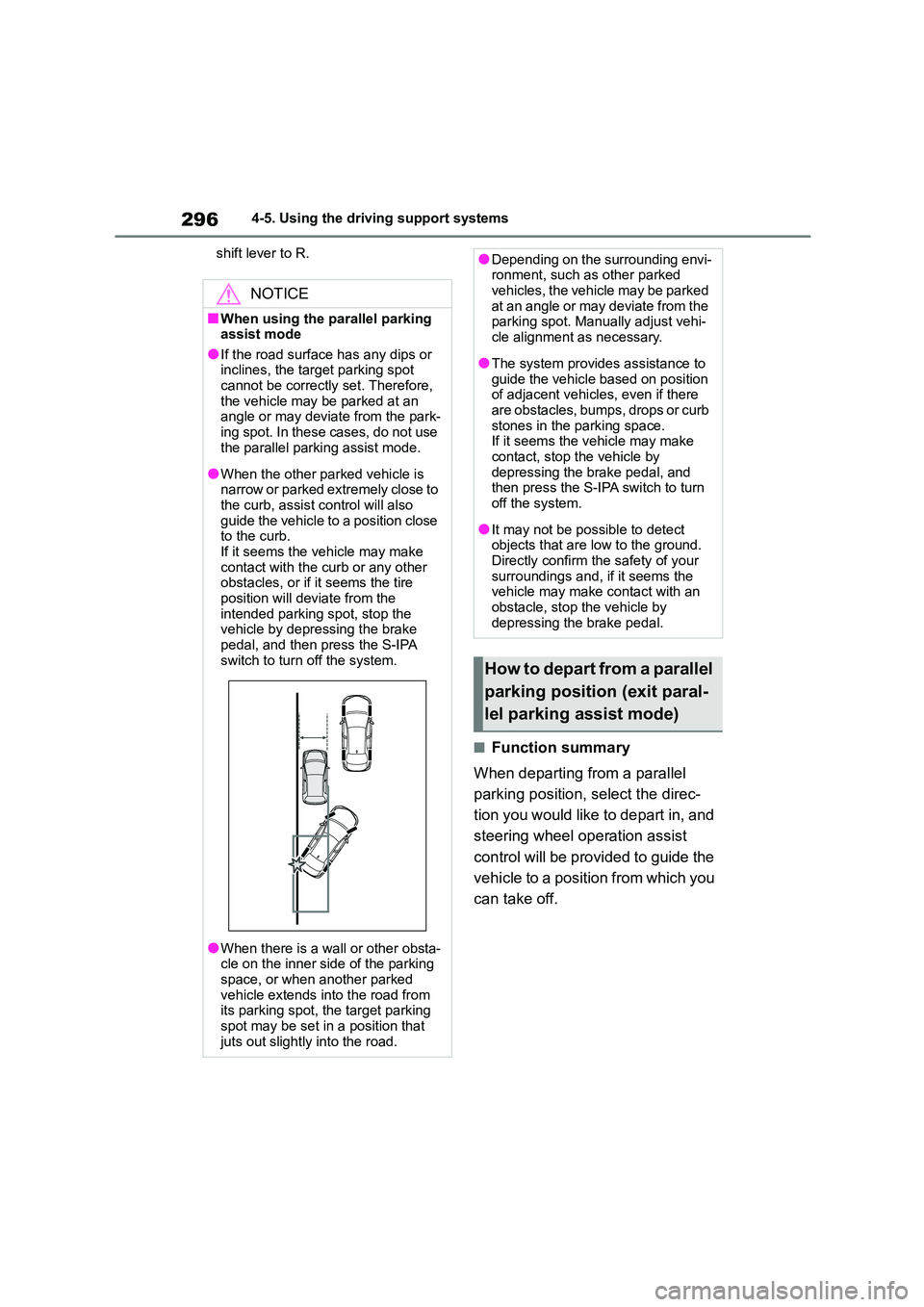
2964-5. Using the driving support systems
shift lever to R.
■Function summary
When departing from a parallel
parking position, select the direc-
tion you would like to depart in, and
steering wheel operation assist
control will be provided to guide the
vehicle to a position from which you
can take off.
NOTICE
■When using the parallel parking assist mode
●If the road surface has any dips or
inclines, the target parking spot cannot be correctly set. Therefore,
the vehicle may be parked at an
angle or may deviate from the park-
ing spot. In these cases, do not use the parallel parking assist mode.
●When the other parked vehicle is narrow or parked extremely close to
the curb, assist co ntrol will also
guide the vehicle to a position close to the curb.
If it seems the vehicle may make
contact with the curb or any other obstacles, or if it seems the tire
position will deviate from the
intended parking spot, stop the vehicle by depressing the brake
pedal, and then press the S-IPA
switch to turn off the system.
●When there is a wall or other obsta- cle on the inner side of the parking
space, or when another parked
vehicle extends into the road from its parking spot, the target parking
spot may be set in a position that
juts out slightly into the road.
●Depending on the surrounding envi- ronment, such as other parked
vehicles, the vehicle may be parked
at an angle or may deviate from the parking spot. Manually adjust vehi-
cle alignment as necessary.
●The system provides assistance to
guide the vehicle based on position
of adjacent vehicles, even if there are obstacles, bumps, drops or curb
stones in the parking space.
If it seems the vehicle may make contact, stop the vehicle by
depressing the brake pedal, and
then press the S-IPA switch to turn off the system.
●It may not be possible to detect objects that are low to the ground.
Directly confirm the safety of your
surroundings and, if it seems the vehicle may make contact with an
obstacle, stop the vehicle by
depressing the brake pedal.
How to depart from a parallel
parking position (exit paral-
lel parking assist mode)
Page 300 of 678
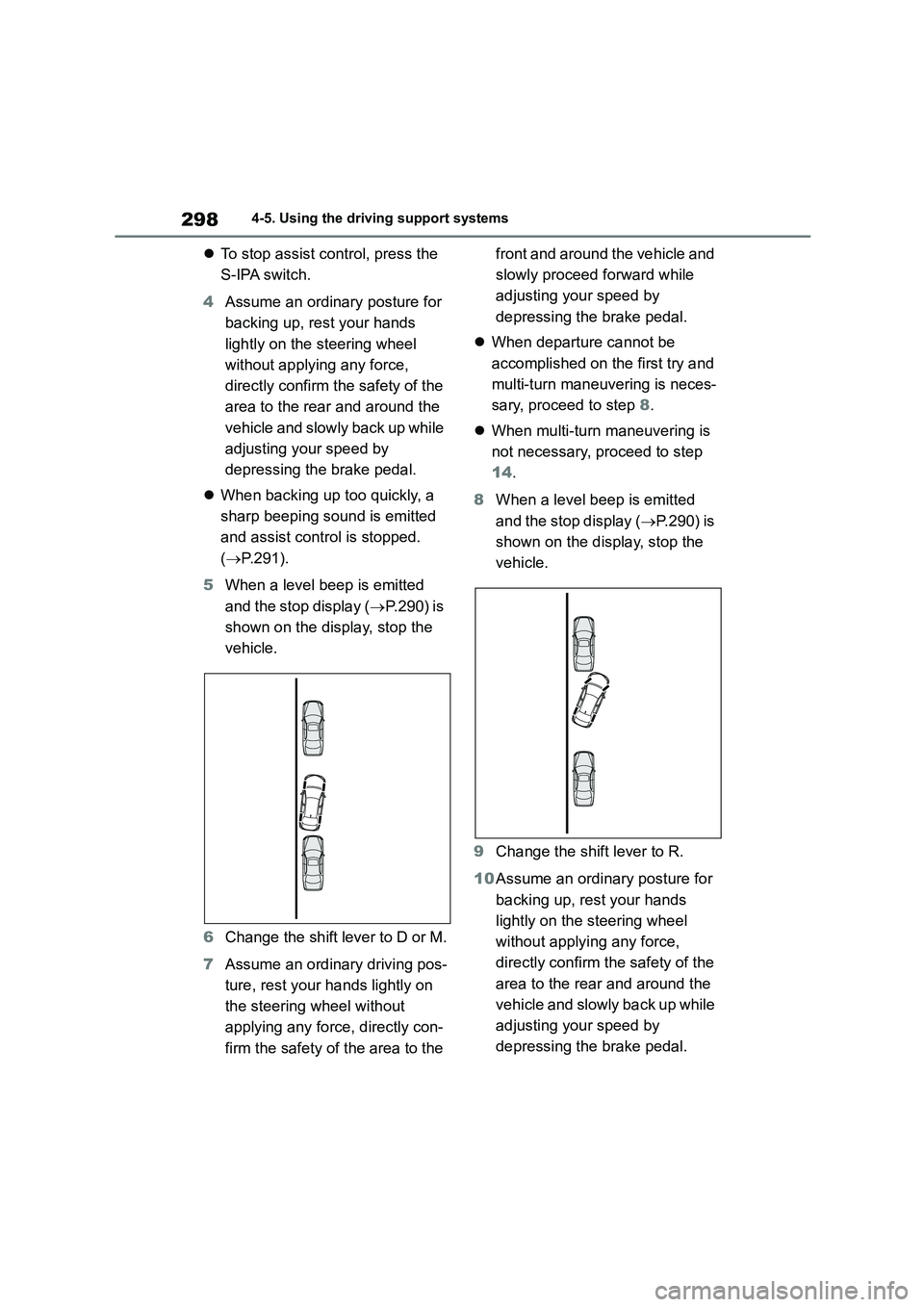
2984-5. Using the driving support systems
To stop assist control, press the
S-IPA switch.
4 Assume an ordinary posture for
backing up, rest your hands
lightly on the steering wheel
without applying any force,
directly confirm the safety of the
area to the rear and around the
vehicle and slowly back up while
adjusting your speed by
depressing the brake pedal.
When backing up too quickly, a
sharp beeping sound is emitted
and assist control is stopped.
( P.291).
5 When a level beep is emitted
and the stop display ( P.290) is
shown on the display, stop the
vehicle.
6 Change the shift lever to D or M.
7 Assume an ordinary driving pos-
ture, rest your hands lightly on
the steering wheel without
applying any force, directly con-
firm the safety of the area to the
front and around the vehicle and
slowly proceed forward while
adjusting your speed by
depressing the brake pedal.
When departure cannot be
accomplished on the first try and
multi-turn maneuvering is neces-
sary, proceed to step 8.
When multi-turn maneuvering is
not necessary, proceed to step
14 .
8 When a level beep is emitted
and the stop display ( P.290) is
shown on the display, stop the
vehicle.
9 Change the shift lever to R.
10 Assume an ordinary posture for
backing up, rest your hands
lightly on the steering wheel
without applying any force,
directly confirm the safety of the
area to the rear and around the
vehicle and slowly back up while
adjusting your speed by
depressing the brake pedal.
Page 301 of 678

299
4
4-5. Using the driving support systems
Driving
Depending on the condition of the park-
ing space, steps 5 to 10 may need to be repeated.
11 When a level beep is emitted
and the stop display ( P.290) is
shown on the display, stop the
vehicle.
12 Change the shift lever to D or M.
13 Assume an ordinary driving pos-
ture, rest your hands lightly on
the steering wheel without
applying any force, directly con-
firm the safety of the area to the
front and around the vehicle and
slowly proceed forward while
adjusting your speed by
depressing the brake pedal.
14 When the vehicle has nearly
reached the take-off point, a
high-pitched beep is emitted
and assist control finishes. From
there, grasp the steering wheel
and proceed forward.
■Exit parallel parking assist mode
●During assist control, if the driver
determines that they are at a position
where take-off is possible and oper- ates the steering wheel, assist control
is stopped at that position.
●Assist control cannot be used if there
are no parked vehicles ahead, or if the
gap between the front of your vehicle and the vehicle parked ahead is too
large.
●When using the exit parallel parking
assist mode, the assist mode may be
not be able to operate depending on the surrounding environment.
■When using the exit parallel park-
ing assist mode
Do not use exit parallel parking assist mode in the following situations as it
may not operate properly:
●When the road surface is not paved or
is rough, such as gravel.
●When there is a rut or other depres-
sion in the road to the side of your
vehicle.
●When the road to the side of your
vehicle is sloped.
●When any of the following are behind
Page 304 of 678
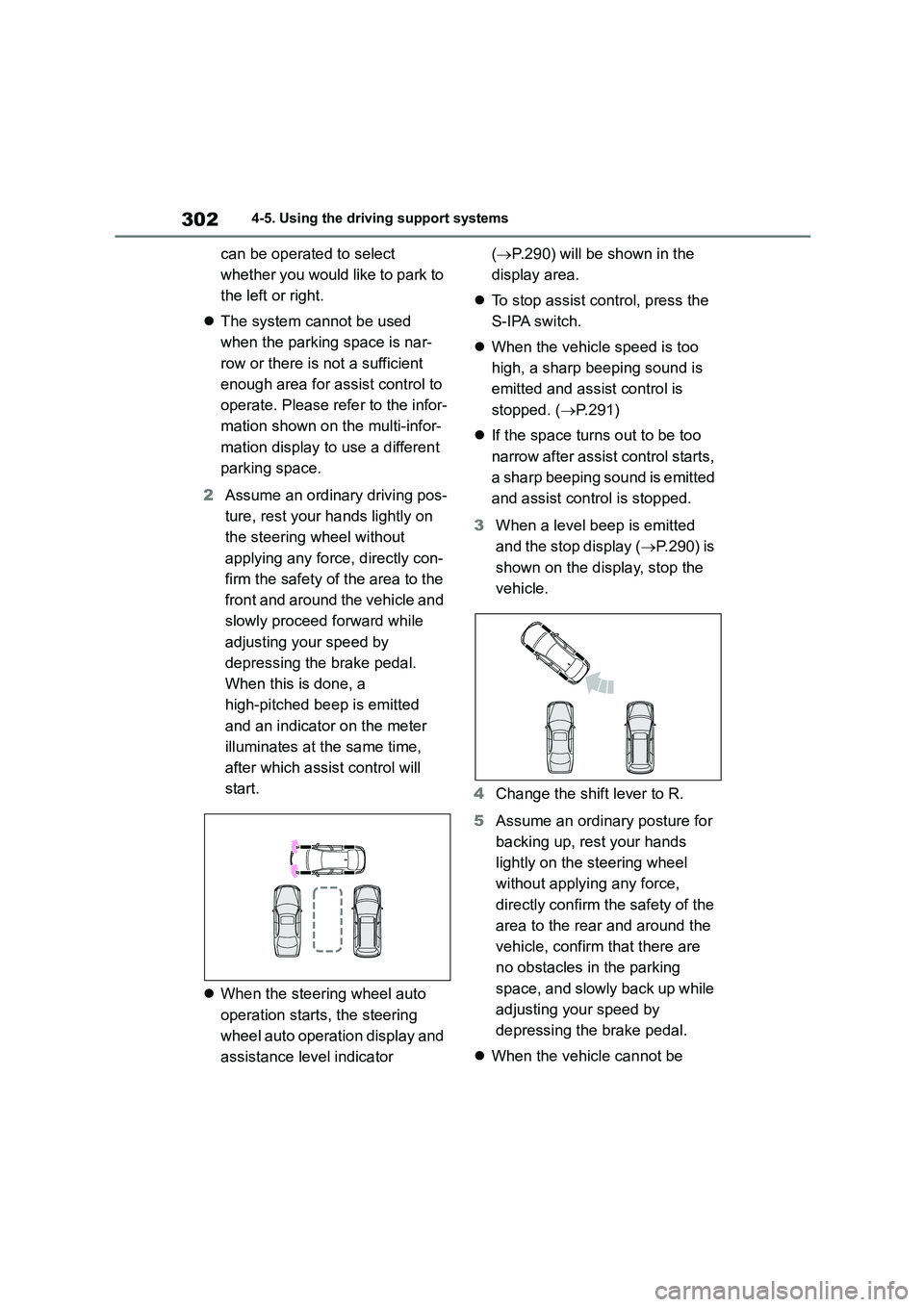
3024-5. Using the driving support systems
can be operated to select
whether you would like to park to
the left or right.
The system cannot be used
when the parking space is nar-
row or there is not a sufficient
enough area for assist control to
operate. Please refer to the infor-
mation shown on the multi-infor-
mation display to use a different
parking space.
2 Assume an ordinary driving pos-
ture, rest your hands lightly on
the steering wheel without
applying any force, directly con-
firm the safety of the area to the
front and around the vehicle and
slowly proceed forward while
adjusting your speed by
depressing the brake pedal.
When this is done, a
high-pitched beep is emitted
and an indicator on the meter
illuminates at the same time,
after which assist control will
start.
When the steering wheel auto
operation starts, the steering
wheel auto operation display and
assistance level indicator
( P.290) will be shown in the
display area.
To stop assist control, press the
S-IPA switch.
When the vehicle speed is too
high, a sharp beeping sound is
emitted and assist control is
stopped. ( P.291)
If the space turns out to be too
narrow after assist control starts,
a sharp beeping sound is emitted
and assist control is stopped.
3 When a level beep is emitted
and the stop display ( P.290) is
shown on the display, stop the
vehicle.
4 Change the shift lever to R.
5 Assume an ordinary posture for
backing up, rest your hands
lightly on the steering wheel
without applying any force,
directly confirm the safety of the
area to the rear and around the
vehicle, confirm that there are
no obstacles in the parking
space, and slowly back up while
adjusting your speed by
depressing the brake pedal.
When the vehicle cannot be
Page 305 of 678
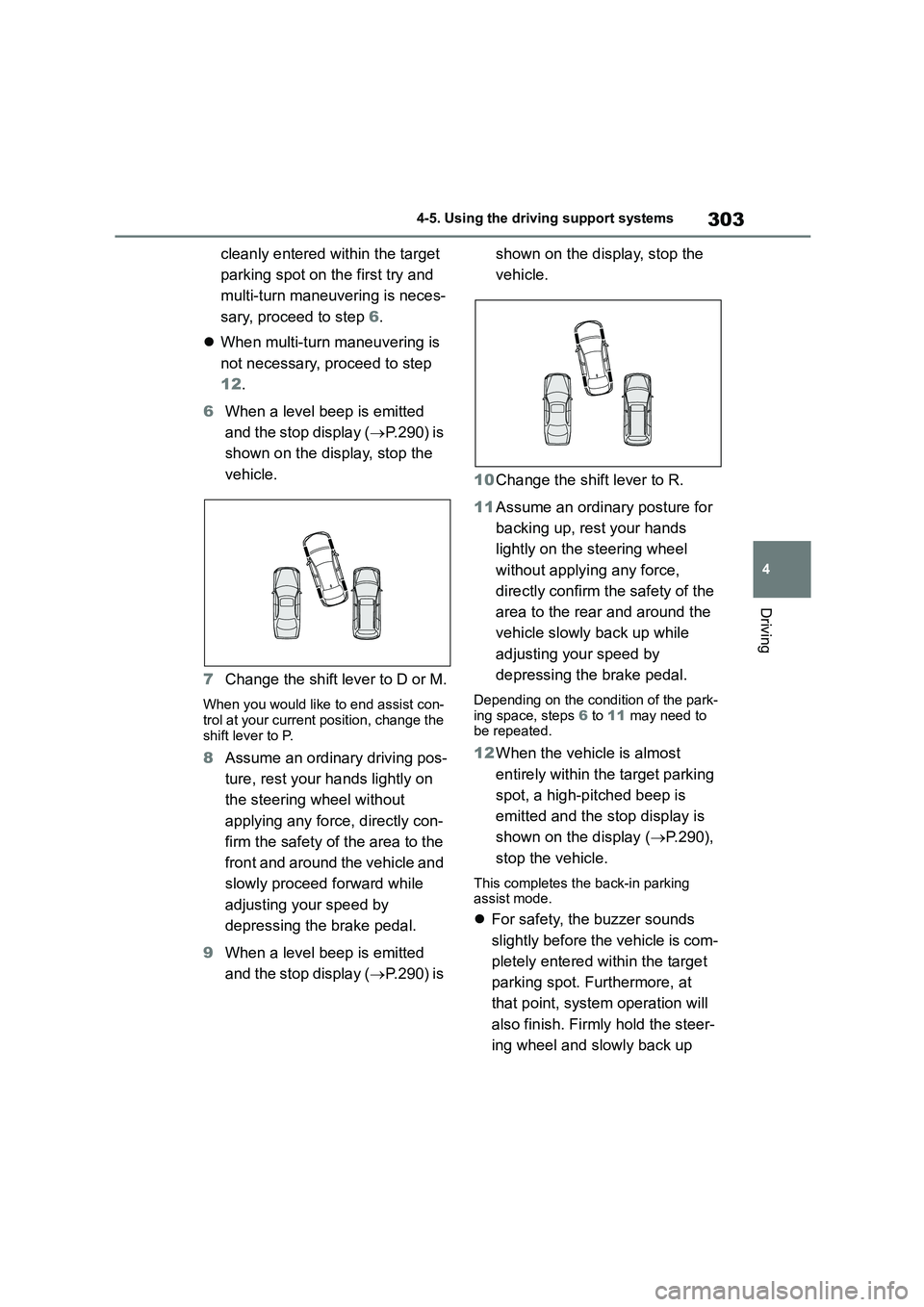
303
4
4-5. Using the driving support systems
Driving
cleanly entered within the target
parking spot on the first try and
multi-turn maneuvering is neces-
sary, proceed to step 6.
When multi-turn maneuvering is
not necessary, proceed to step
12 .
6 When a level beep is emitted
and the stop display ( P.290) is
shown on the display, stop the
vehicle.
7 Change the shift lever to D or M.
When you would like to end assist con-
trol at your current position, change the
shift lever to P.
8 Assume an ordinary driving pos-
ture, rest your hands lightly on
the steering wheel without
applying any force, directly con-
firm the safety of the area to the
front and around the vehicle and
slowly proceed forward while
adjusting your speed by
depressing the brake pedal.
9 When a level beep is emitted
and the stop display ( P.290) is
shown on the display, stop the
vehicle.
10 Change the shift lever to R.
11 Assume an ordinary posture for
backing up, rest your hands
lightly on the steering wheel
without applying any force,
directly confirm the safety of the
area to the rear and around the
vehicle slowly back up while
adjusting your speed by
depressing the brake pedal.
Depending on the condition of the park-
ing space, steps 6 to 11 may need to
be repeated.
12 When the vehicle is almost
entirely within the target parking
spot, a high-pitched beep is
emitted and the stop display is
shown on the display ( P.290),
stop the vehicle.
This completes the back-in parking
assist mode.
For safety, the buzzer sounds
slightly before the vehicle is com-
pletely entered within the target
parking spot. Furthermore, at
that point, system operation will
also finish. Firmly hold the steer-
ing wheel and slowly back up